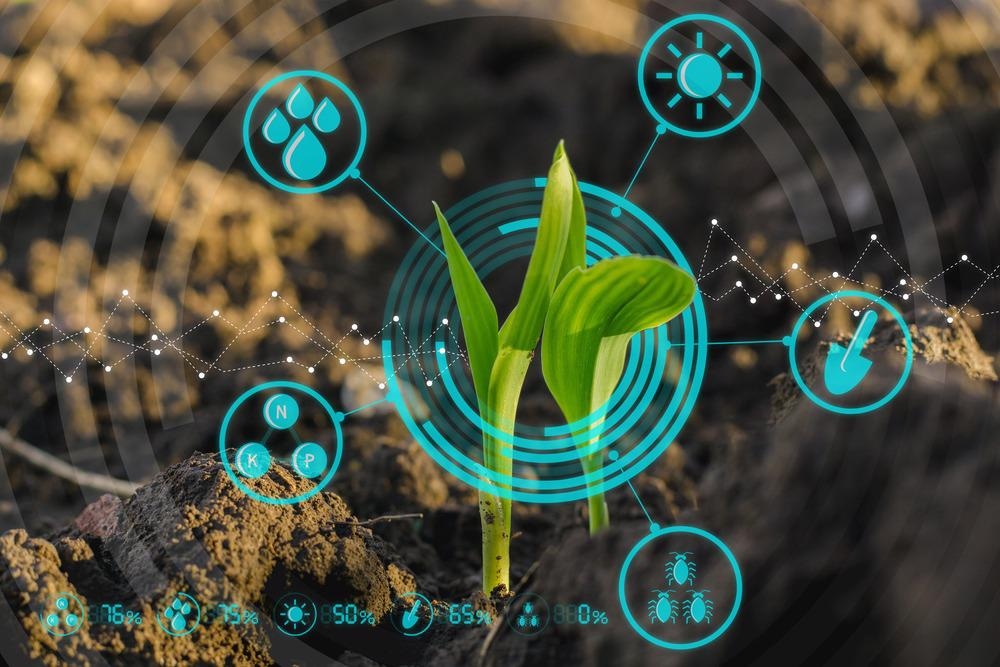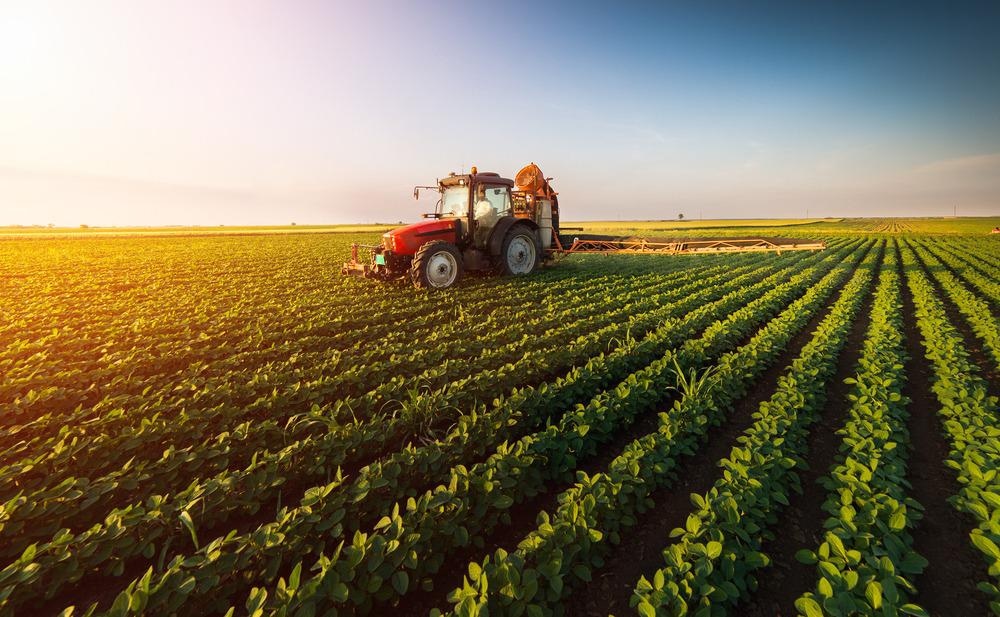The continual increase in the global population has substantially increased the demand for food. However, the rapid changes in the climate and declining soil quality have impacted agricultural produce. Integrating knowledge from diverse fields, such as material science and informatics, and implementing it in agriculture could help meet the global food demand by increasing agricultural yield.

Image Credit: Lamyai/Shutterstock.com
Nanoinformatics combines existing models for nutrient cycles and crop productivity to optimize nutrient capture and uptake. Additionally, nanoinformatics could also help design optimal delivery of fertilizers and pesticides, and enrich soil microbe diversity that would eventually aid in the luxuriant crop production.
What is Nanoinformatics?
Scientists have described nanoinformatics as “the science and practice of determining the information that is relevant to the nanoscale science and engineering community and developing and implementing effective mechanisms for collecting, validating, storing, sharing, analyzing, modeling and applying that information”. This branch of science is still in its infancy as most data are scattered in the form of publications. However, nanoinformatics is steadily advancing with the formation of nanoparticle data management.
Nanoinformatics involves the meticulous application of information devices and tools to assist nanotechnology projects, such as developing new drugs through nanomedicine and nanoagriculture.
In a nutshell, nanoinformatics deals with extracting, processing, analyzing, and evaluating an enormous amount of information, using informatics. Recently, the ISA-TAB-Nano standard database has been developed, where ISA stands for Investigation Study Assay and TAB refers to tab delimiting format.
In this database, all information about nanomaterials, small molecules, biological specimens, and assay characterization data are available in TAB-delimited files. Other databases include caNanoLab and Nanomaterial Registry, associated with data sharing and developing data standards.
Nanoinformatics in Agriculture
Recently, scientists have applied machine learning in nanomaterials risk assessment. This has enabled designing safe and eco-friendly nanoproducts. For instance, nanoQSAR models connect specific properties of nanomaterials with their ability to be taken up by cells or organisms and assess their impact on them. This model also establishes surface functionalizations that deal with enhancing protein binding and cellular associations, which is a prerequisite for internalization.
Nanoinformatics assists precision nano-agriculture mainly by optimizing the controlled release of agrochemicals. Deep learning employs an automatic data splitting algorithm to evaluate the criteria suitable for understanding various factors, related to the type of nanomaterials, plants, soils, and climate, which influence the release rate of active ingredients. All these factors affect selection parameters for the formulation of agrochemicals and nanofertilizers.
The models associated with nanoinformatics require a significant amount of data to train and validate. One of the limitations of the current nanoinformatics is the lack of enough data uploaded in the databases.
However, scientists are working extensively hard to overcome this shortcoming by metadata generation by utilizing Electronic Laboratory Notebooks, automated upload of nanosafety knowledgebases, and advancing agriculture-related datasets.
Scientists have recently utilized in silico computer-based chemical modeling technologies to expedite risk assessment of nano-based pesticides. They observed that quantum chemistry-based tools could characterize the structure and assess the stability of organic compound isomers.
Nanoinformatics and Artificial Intelligence
Smart agriculture, which involves the combination of nanotechnology, artificial intelligence (AI), and machine learning, has improved the nutritional uptake of plants and promoted sustainable agriculture. The optimal delivery of agrochemicals to crops using nanotechnology-based delivery systems has reduced environmental pollution and minimized adverse effects of agricultural practice on human health.
Nanoinformatics plays an important role in investigating the plant and ecosystem responses to the newly designed nano-agriculture-based parameters and optimizing them to promote safe and sustainable agriculture.
In this context, AI predicts the impact of nanomaterials on the agricultural ecosystem. Additionally, it may also predict the effect of agro-nanoformulations in reducing soil and water pollution. This is important because, in the conventional system of agriculture, the excess use of synthetic chemicals that contains heavy metals often contaminates the neighboring water bodies and groundwater.
Nanoinformatics enables safer-by-design development of nano-based agrochemicals using AI technology, which provides important information via integrating extensive experimental data from across different soil conditions, data on physicochemical properties of nanomaterials, and more.

Image Credit: Fotokostic/Shutterstock.com
Linking existing models for nutrient cycling and crop productivity with nanoinformatics approaches are thought to improve agricultural yield, safely and sustainably. Recently, an international team of researchers led by the University of Birmingham have highlighted some steps that could help assess the long-term impact of nanomaterials in agriculture.
Nanoinformatics based on AI application could help exploit the power of nanomaterials safely and sustainably in agriculture. Some of the important aspects highlighted by the research team are:
- It is important to understand the long-term fate of nanomaterials in agricultural environments, which include the interaction of nanomaterials with roots, leaves, and soil.
- Evaluation of the long-term life cycle impact of nanomaterials in the agricultural ecosystem, for instance, how soil is impacted by the repeated application of nanomaterials.
- Utilization of systems-based applications to promote safe nano-enabled agriculture. This involves optimal utilization of existing data on crop yield, soil quality, and nutrient use efficiency to predict how nanomaterials could behave in the environment.
- Utilization of AI and machine learning to determine the main factors that will govern the behavior of nanomaterials in agricultural settings.
Dr. Peng Zhang of the University of Birmingham stated that computational approaches including AI and machine learning have a critical role in advancing nano-based agriculture.
These approaches have started to gain regulatory acceptance for the safety assessment of nanomaterials. The utilization of nanoinformatics will help scientists design parameters to develop optimal nano-based fertilizers and pesticides that will have a minimal adverse effect on soil health and improve crop growth and productivity.
Continue reading: What is Nanoinformatics?
References and Future Reading
An, C., et al. (2022) Nanomaterials and nanotechnology for the delivery of agrochemicals: strategies towards sustainable agriculture. Journal of Nanobiotechnology, 20, 11. https://doi.org/10.1186/s12951-021-01214-7
Nwankwo, W. and Ukhurebor, K. (2021) Nanoinformatics: Opportunities and challenges in the development and delivery of healthcare products in developing countries. IOP Conference Series: Earth and Environmental Science. 655. 012018. http://dx.doi.org/10.1088/1755-1315/655/1/012018
Zang, P. et al. (2021) Nanotechnology and Artificial Intelligence to Enable Sustainable and 2 Precision Agriculture. Nanotechnology and artificial intelligence to enable sustainable and precision agriculture', Nature Plants. 7. pp. 864–876. https://doi.org/10.1038/s41477-021-00946-6
University of Birmingham. (2021). Nanotech and AI could hold key to unlocking global food security challenge. [Online] Available at: https://www.sciencedaily.com/releases/2021/06/210624114428.htm
Ali. M. (2021) Sustainable And Precision Farming Through Nanotechnology And Artificial Intelligence. [Online] Available at: https://cropforlife.com/sustainable-and-precision-farming-through-nanotechnology-and-artificial-intelligence/
Disclaimer: The views expressed here are those of the author expressed in their private capacity and do not necessarily represent the views of AZoM.com Limited T/A AZoNetwork the owner and operator of this website. This disclaimer forms part of the Terms and conditions of use of this website.